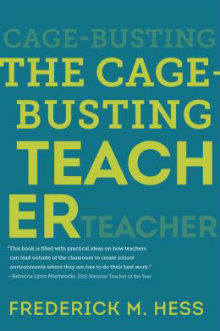Cage-Busting Teachers Go After Solutions
The Cage-Busting Teacher
By Frederick M. Hess
(Harvard Education Press, 2015 – Learn more)

As a teacher, I can tell you that my job is comprised of three, distinct elements—passion, instructional practice, and…frustration. As an avid reader of anything and everything to do with education, I know that there is plenty written on the first two components, but not nearly enough on the latter. That’s why I was excited to pick up The Cage-Busting Teacher.
Author Frederick Hess points out that we don’t have to go far to find teachers who love what they do in the classroom, but whose time, energy, and passion are being slowly siphoned by the habits, routines, rules, and regulations that seem to be an inevitable part of the profession.

In other words, we allow ourselves to be placed in a “cage.”
More hard cider than comforting soup
After only a few pages, readers understand clearly that this book is not designed to make teachers feel better about themselves or their profession. Reading it feels more like an appendectomy than it does Chicken Soup for the Teacher’s Soul.
The book details several painful but necessary steps that we must take in order to improve the health of our schools and boost our professional strength. This book is about agency, strategic action, and persistent problem-solving in education. It calls upon educators to bust out of the cage and affect change in the schools and systems where we work. As Rick Hess puts it…
Cage-busting is concrete, precise, and practical. It asks what the problem is, seeks workable solutions, and figures out how to put those into practice. It asks precisely why schools are doing this and tallies the number of minutes wasted. Cage-busting teachers are less interested in what policy makers or district leaders ought to do than how teachers can make those things happen (p. 13).
An army of educational expertise
Whether it’s his blog, his books or his work in policy, Rick Hess is known for having plenty to say on education reform. The real power of The Cage-Busting Teacher, however, doesn’t stem from his clever use of movie quotes or from his candid commentary on teacher unions, bad policy, sub-par professional development, and endless educational administrivia.
Instead, the book’s strength and usefulness results from the insight and suggestions shared by hundreds of cage-busting teachers, administrators, teacher advocates, union leaders, and others who collaborated with him on the project. Don’t get me wrong. Hess still does plenty of talking, but he’s also clearly listening. He backs up his usual, irreverent banter with dozens of examples of teachers enacting significant and lasting changes in their schools, districts, and beyond.
Award-winning teachers share tips and tactics for supporting failing students, streamlining data and assessments, and minimizing wasted time. Teacher leaders offer suggestions on working with difficult colleagues and on getting support from the school community and principal. Policy makers and administrators weigh-in on improving our professional networks and boosting the prestige of the profession. (Disclosure: In one chapter, Hess includes a tidbit from a conversation he and I had on the phone regarding schools that successfully customize professional development.)
The result is a useful handbook of cage-busting solutions for educators who want to build their own authority, problem solve, improve school culture, influence policy, and find other ways to extend their influence beyond the walls of the classroom.
Some of everything for just about everyone
I really appreciate the functional, a la carte structure of the Cage-Busting Teacher. With the exception of the required opening chapter that outlines the ‘cage’ analogy used throughout the book, you could really read or skip just about any chapter and be okay.
There’s a section on general problem solving and another on managing relationships with higher-ups in your building and district. The chapter on ‘Tackling Everyday Problems’ serves as a catch-all for issues in teacher leadership, collaboration, instructional technology, professional development, and a handful of other topics.
There are entire chapters on the good, bad, and ugly of politics, policy, teacher unions, and educators who leave the classroom. Hess repeatedly cautions against all-out enlistment in anyone else’s grand crusade. Instead, he asks would-be cage-busters to “examine the logic of each proposal, understand its practical frailties, embrace the good, and reject or address the bad” (Hess, 2015, p. 29).
By the end of the book, I felt like I had learned how to do judo, a page at a time. I had acquired the ability to identify opponents to my cause, then figured out ways to redirect their hostility and aggression to reinforce what I wanted to do.
Focus your frustration on positive action
Any teacher who reads The Cage-Busting Teacher will find plenty that they disagree with. But…they will also learn quite a bit about their potential and influence as an educator. My prediction: the book will sell pretty well. After all, there are plenty of disgruntled educators who would rather improve the profession than walk away from it. The Cage-Busting Teacher does what the title promises to do. It gives each of us permission—and tools—to start transforming education.
Dr. Curtis Chandler, the 2011 Kansas Teacher of the Year, is an education specialist and staff developer with the Kansas education support agency ESSDACK. “I am a middle school teacher through and through,” he says. “My teaching has been 90% grade 6-8.” Chandler’s work and ideas have been featured in Rick Hess’ The Cage-Busting Teacher, and Kristin Magette’s Embracing Social Media: A Practical Guide to Manage Risk and Leverage Opportunity. At his personal blog, Better Learning for Schools, he often writes about “capacity building tools for educators and administrators.”


































